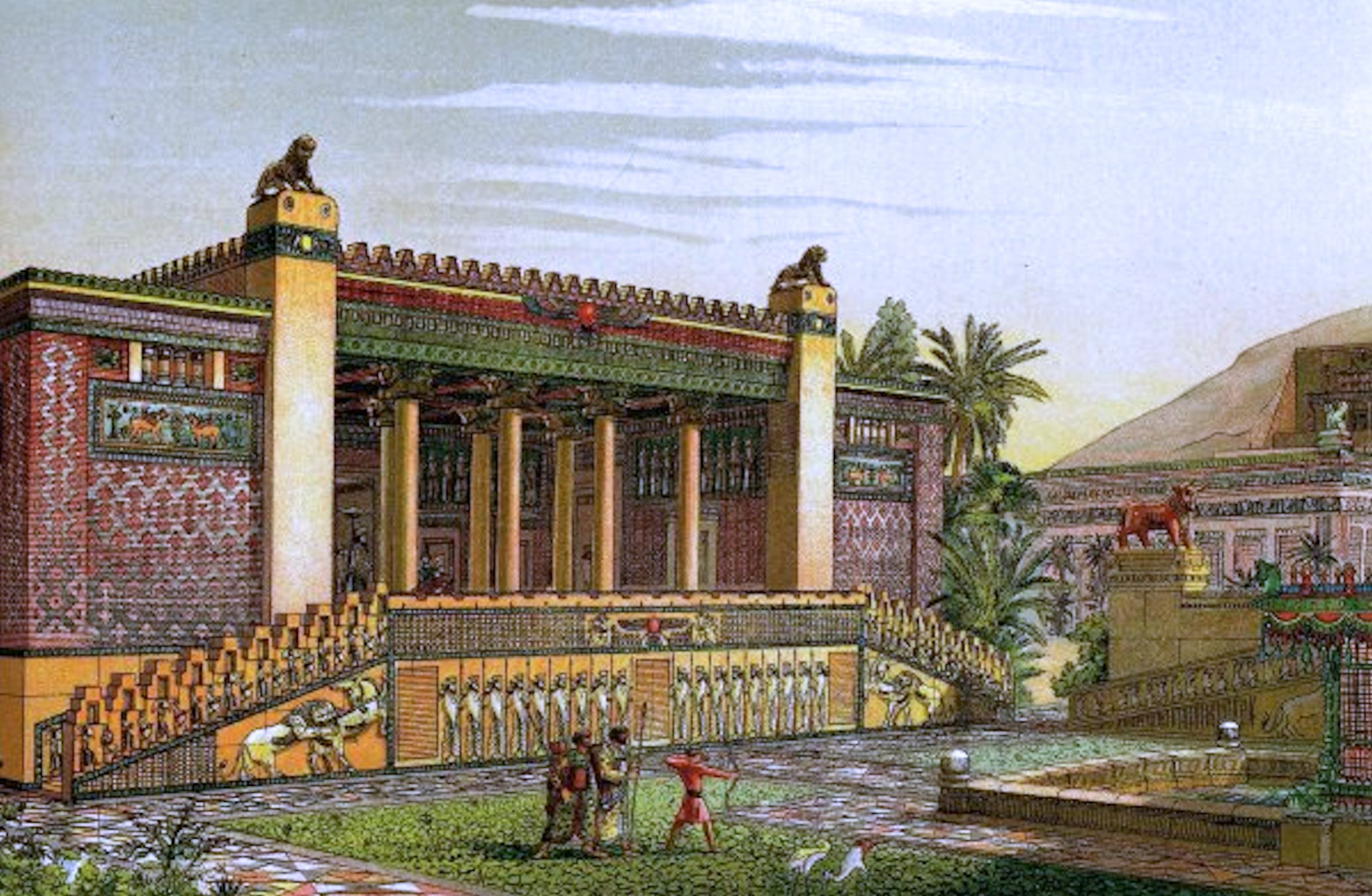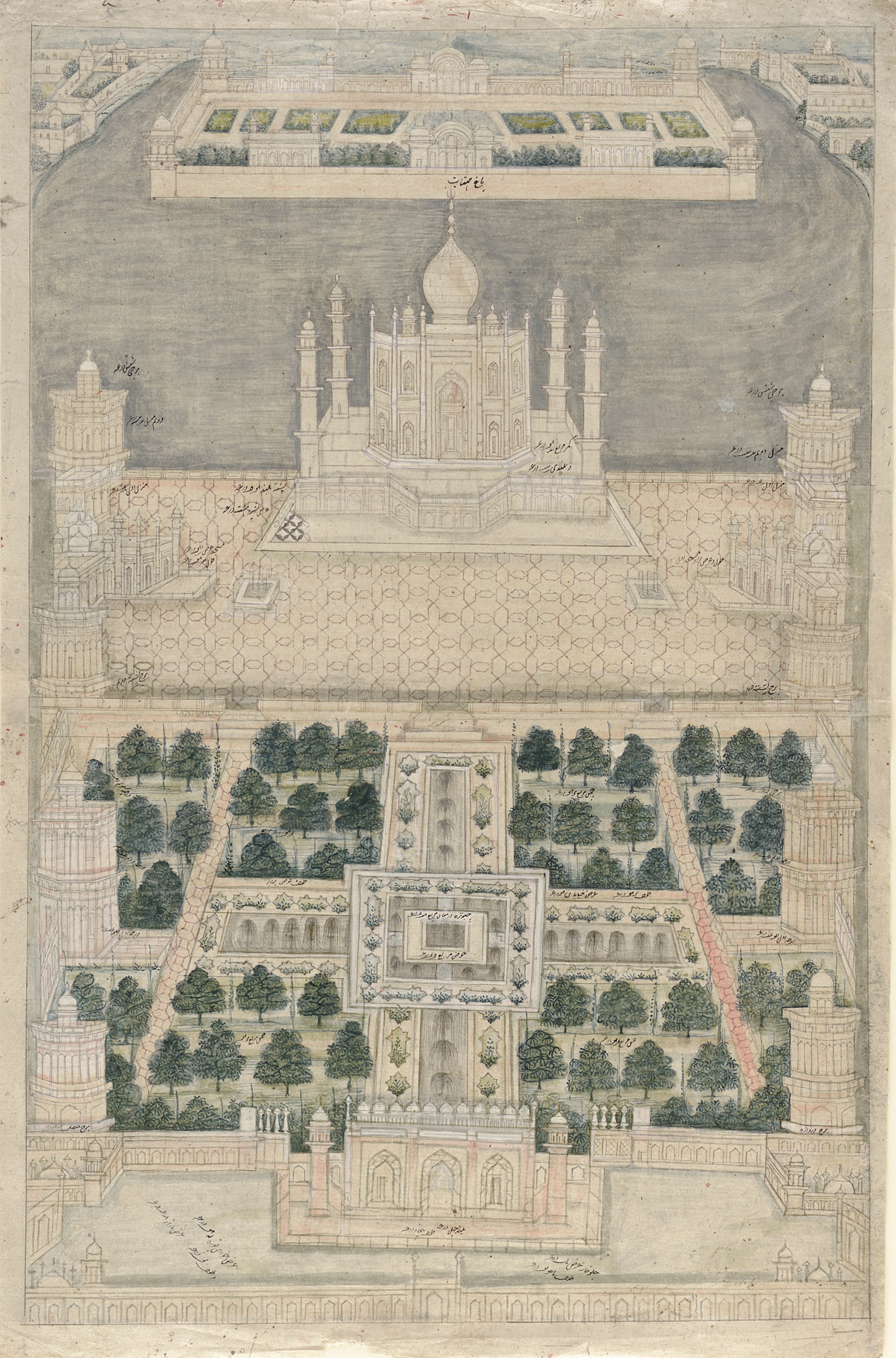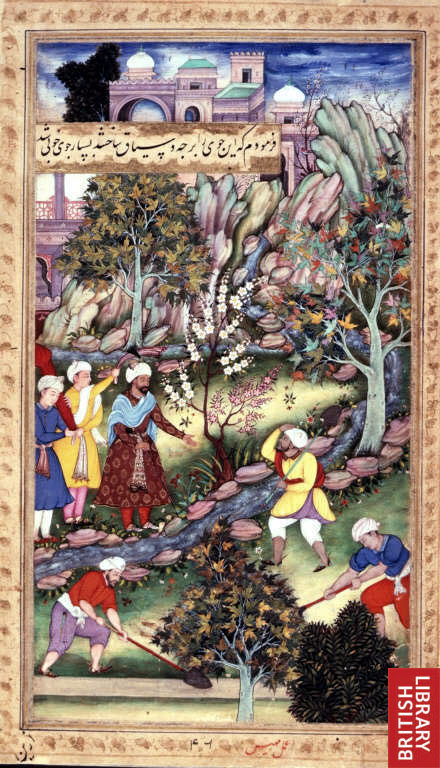|
Charbagh
''Charbagh'' or ''Chahar Bagh'' ( ''chahār bāgh'', ''chārbāgh'', ''chār bāgh'', meaning "four gardens") is a Persian and Indo-Persian quadrilateral garden layout based on the four gardens of Paradise mentioned in the Quran. The quadrilateral garden is divided by walkways or flowing water into four smaller parts. They are found in countries throughout Western Asia and South Asia, including Iran and India. Persian garden concept of chahar bagh The quadrilateral Charbagh concept is interpreted as the four gardens of Paradise mentioned in Chapter (Surah) 55, Ar-Rahman "The Beneficient", in the Qur'an: One of the hallmarks of Charbagh garden is the four-part garden laid out with axial paths that intersect at the garden's centre. This highly structured geometrical scheme, called the chahar bagh, became a powerful method for the organization and domestication of the landscape, itself a symbol of political territory. The concept of chahar bagh is not only mentioned in Qu ... [...More Info...] [...Related Items...] OR: [Wikipedia] [Google] [Baidu] |
Mughal Gardens
Mughal gardens are a type of garden built by the Mughals. This style was influenced by the Persian gardens particularly the Charbagh structure, which is intended to create a representation of an earthly utopia in which humans co-exist in perfect harmony with all elements of nature. Significant use of rectilinear layouts are made within the walled enclosures. Some of the typical features include pools, fountains and canals inside the gardens. Afghanistan, Bangladesh, India, and Pakistan have a number of Mughal gardens which differ from their Central Asian predecessors with respect to "the highly disciplined geometry". History The founder of the Mughal empire, Babur, described his favourite type of garden as a charbagh. The term '' bāgh'', ''baug'', ''bageecha'' or ''bagicha'' is used for the garden. This word developed a new meaning in South Asia, as the region lacked the fast-flowing streams required for the Central Asian charbagh. The Aram Bagh of Agra is thought to have ... [...More Info...] [...Related Items...] OR: [Wikipedia] [Google] [Baidu] |
Persian Gardens
The tradition and style of garden design represented by Persian gardens or Iranian gardens ( fa, باغ ایرانی), an example of the paradise garden, has influenced the design of gardens from Andalusia to India and beyond. The gardens of the Alhambra show the influence of Persian garden philosophy and style in a Moorish palace scale, from the era of al-Andalus in Spain. Humayun's Tomb and the Taj Mahal have some of the largest Persian gardens in the world, from the era of the Mughal Empire in India. Concept and etymology From the time of the Achaemenid Empire, the idea of an earthly paradise spread through Persian literature and example to other cultures, both the Hellenistic gardens of the Seleucid Empire and the Ptolemies in Alexandria. The Avestan word ''pairidaēza-'', Old Persian *''paridaida-'',Although the genuine Old Persian form must have been *''paridaida-'', Modern Persian ''palīz'' 'garden' from Middle Persian ''palēz'' presupposes a variant *''pardaiza-'' (with ... [...More Info...] [...Related Items...] OR: [Wikipedia] [Google] [Baidu] |
Taj Mahal
The Taj Mahal (; ) is an Islamic ivory-white marble mausoleum on the right bank of the river Yamuna in the Indian city of Agra. It was commissioned in 1631 by the Mughal emperor Shah Jahan () to house the tomb of his favourite wife, Mumtaz Mahal; it also houses the tomb of Shah Jahan himself. The tomb is the centrepiece of a complex, which includes a mosque and a guest house, and is set in formal gardens bounded on three sides by a crenellated wall. Construction of the mausoleum was essentially completed in 1643, but work continued on other phases of the project for another 10 years. The Taj Mahal complex is believed to have been completed in its entirety in 1653 at a cost estimated at the time to be around ₹32 million, which in 2020 would be approximately 70 billion (about US $1 billion). The construction project employed some 20,000 artisans under the guidance of a board of architects led by the court architect to the emperor, Ustad Ahmad Lahauri. ... [...More Info...] [...Related Items...] OR: [Wikipedia] [Google] [Baidu] |
Paradise Garden
The paradise garden is a form of garden of Old Iranian origin, specifically Achaemenid which is formal, symmetrical and most often, enclosed. The most traditional form is a rectangular garden split into four quarters with a pond in the center, a four-fold design called ''chahar bagh'' (“four gardens”). One of the most important elements of paradise gardens is water, with ponds, canals, rills, and fountains all being common features. Scent is an essential element with fruit-bearing trees and flowers selected for their fragrance. It is also often referred to as an Islamic garden. The form of garden spread throughout Egypt and the Mediterranean during the Muslim Arabic conquests, reaching as far as India and Spain. Etymology Originally denominated by a single noun denoting "a walled-in compound or garden", from "''pairi''" ("around") and "''daeza''" or "''diz''" ("wall", "brick", or "shape"), philosopher and historian Xenophon of Athens borrowed the Old Iranian ''*paridaiza( ... [...More Info...] [...Related Items...] OR: [Wikipedia] [Google] [Baidu] |
Ismaili Centre, London
The Ismaili Centre, London is one of six such centres world-wide. Established in South Kensington more than thirty years ago, it is a religious, social and cultural meeting place for the Ismaili Muslim community in the United Kingdom and is the first such centre to be specially designed and built for Ismailis in the Western world. Establishment The Ismaili Centre, London was inaugurated on 24 April 1985 by then Prime Minister Margaret Thatcher, in the presence of His Highness the Aga Khan, the 49th Imam (spiritual leader) of the Ismaili Muslims. It was the first religious, cultural and social space specifically designed for the Ismaili community in the Western world. The Ismaili community had been in the United Kingdom since as early as 1951, when they established a religious, cultural and social centre at Kensington Court. It was moved to Palace Gate in 1957, but the needs of the growing community increased over time, and a site at Cromwell Gardens was acquired in the 19 ... [...More Info...] [...Related Items...] OR: [Wikipedia] [Google] [Baidu] |
Mehtab Bagh
Mehtab Bagh () is a charbagh complex in Agra, North India. It lies north of the Taj Mahal complex and the Agra Fort on the opposite side of the Yamuna River, in the flood plains. The garden complex, square in shape, measures about and is perfectly aligned with the Taj Mahal on the opposite bank. During the rainy season, the ground becomes partially flooded. History The Mehtab Bagh garden was the last of eleven Mughal-built gardens along the Yamuna opposite the Taj Mahal and the Agra Fort. The garden was built by Emperor Babur (d. 1530). It is also noted that Emperor Shah Jahan had identified a site from the crescent-shaped, grass-covered floodplain across the Yamuna River as an ideal location for viewing the Taj Mahal. It was then created as "a moonlit pleasure garden called Mehtab Bagh." White plaster walkways, airy pavilions, pools and fountains were also created as part of the garden, with fruit trees and Narcissus (plant), narcissus. The garden was designed as an integral ... [...More Info...] [...Related Items...] OR: [Wikipedia] [Google] [Baidu] |
Agra
Agra (, ) is a city on the banks of the Yamuna river in the Indian state of Uttar Pradesh, about south-east of the national capital New Delhi and 330 km west of the state capital Lucknow. With a population of roughly 1.6 million, Agra is the fourth-most populous city in Uttar Pradesh and List of cities in India by population, twenty-third most populous city in India. Agra's notable historical period began during Sikandar Lodi's reign, but the golden age of the city began with the Mughals. Agra was the foremost city of the Indian subcontinent and the capital of the Mughal Empire under Mughal emperors Babur, Humayun, Akbar, Jahangir and Shah Jahan. Under Mughal rule, Agra became a centre for learning, arts, commerce, and religion, and saw the construction of the Agra Fort, Sikandra, Agra, Sikandra and Agra's most prized monument, the Taj Mahal, built by Shah Jahan as a mausoleum for his favourite empress. With the decline of the Mughal empire in the late 18th century, the ci ... [...More Info...] [...Related Items...] OR: [Wikipedia] [Google] [Baidu] |
:Category:Persian Words And Phrases
See also Wiktionary:Persian language Words and phrases A word is a basic element of language that carries an semantics, objective or pragmatics, practical semantics, meaning, can be used on its own, and is uninterruptible. Despite the fact that language speakers often have an intuitive grasp of w ... Iranian words and phrases {{CatAutoTOC ... [...More Info...] [...Related Items...] OR: [Wikipedia] [Google] [Baidu] |
Babur
Babur ( fa, , lit= tiger, translit= Bābur; ; 14 February 148326 December 1530), born Mīrzā Zahīr ud-Dīn Muhammad, was the founder of the Mughal Empire in the Indian subcontinent. He was a descendant of Timur and Genghis Khan through his father and mother respectively.F. LehmannẒahīr-al-Dīn Moḥammad Bābor In Encyclopædia Iranica. Online Ed. December 1988 (updated August 2011). "Bābor, Ẓahīr-al-Dīn Moḥammad son of Umar Sheikh Mirza, (6 Moḥarram 886-6 Jomādā I 937/14 February 1483 – 26 December 1530), Timurid prince, military genius, and literary craftsman who escaped the bloody political arena of his Central Asian birthplace to found the Mughal Empire in India. His origin, milieu, training, and education were steeped in Muslim culture and so Bābor played significant role for the fostering of this culture by his descendants, the Mughals of India, and for the expansion of Islam in the Indian subcontinent, with brilliant literary, artistic, and histo ... [...More Info...] [...Related Items...] OR: [Wikipedia] [Google] [Baidu] |
Bagh-e Babur
The Garden of Babur (locally called Bagh-e Babur; fa, باغ بابر, ''bāġ-e bābur'') is a historic park in Kabul, Afghanistan, and also has the tomb of the first Mughal emperor Babur. The garden is thought to have been developed around 1528, when Babur gave orders for the construction of an "avenue garden" in Kabul, described in some detail in his memoirs, the ''Baburnama''. It was the tradition of Mughal princes to develop sites for recreation and pleasure during their lifetime and choose one of these as the last resting place. The site continued to be of significance to Babur's successors; Jahangir made a pilgrimage to the site in 1607, when he ordered that all gardens in Kabul be surrounded by walls, that a prayer platform be laid in front of Babur's grave, and an inscribed headstone placed at its head. During the visit of the Mughal Emperor Shah Jahan in 1638, a marble screen was erected around the tomb of Babur, and a mosque built on the terrace below. There are accoun ... [...More Info...] [...Related Items...] OR: [Wikipedia] [Google] [Baidu] |
Kabul
Kabul (; ps, , ; , ) is the capital and largest city of Afghanistan. Located in the eastern half of the country, it is also a municipality, forming part of the Kabul Province; it is administratively divided into 22 municipal districts. According to late 2022 estimates, the population of Kabul was 13.5 million people. In contemporary times, the city has served as Afghanistan's political, cultural, and economical centre, and rapid urbanisation has made Kabul the 75th-largest city in the world and the country's primate city. The modern-day city of Kabul is located high up in a narrow valley between the Hindu Kush, and is bounded by the Kabul River. At an elevation of , it is one of the highest capital cities in the world. Kabul is said to be over 3,500 years old, mentioned since at least the time of the Achaemenid Persian Empire. Located at a crossroads in Asia—roughly halfway between Istanbul, Turkey, in the west and Hanoi, Vietnam, in the east—it is situated in a stra ... [...More Info...] [...Related Items...] OR: [Wikipedia] [Google] [Baidu] |
Mumtaz Mahal
Mumtaz Mahal (/'/; ), born Arjumand Banu Begum (27 April 1593 – 17 June 1631) was the empress consort of the Mughal Empire from 19 January 1628 to 17 June 1631 as the chief consort of the Mughal emperor Shah Jahan. The Taj Mahal in Agra, often cited as one of the Wonders of the World, was commissioned by her husband to act as her tomb. Mumtaz Mahal was born Arjumand Banu Begum in Agra to a family of Persian nobility. She was the daughter of Abu'l-Hasan Asaf Khan, a wealthy Persian noble who held high office in the Mughal Empire, and the niece of Empress Nur Jahan, the chief wife of Emperor Jahangir and the power behind the emperor. She was married at the age of 19 on 10 May 1612 or 16 June 1612 to Prince Khurram, later known by his regnal name Shah Jahan, who conferred upon her the title "Mumtaz Mahal" (Persian: the exalted one of the palace). Although betrothed to Shah Jahan since 1607, she ultimately became his second wife in 1612. Mumtaz and her husband had 14 children, in ... [...More Info...] [...Related Items...] OR: [Wikipedia] [Google] [Baidu] |









